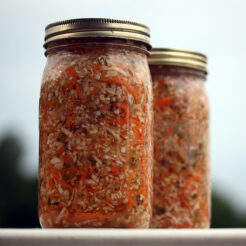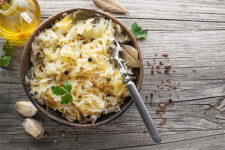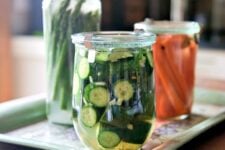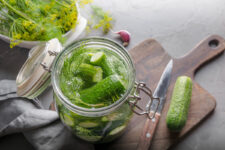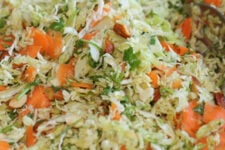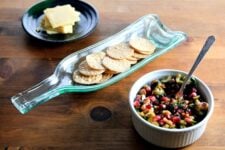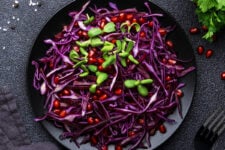Curtido (aka cortido) is a variation on sauerkraut that hails from El Salvador. It is typically served in that country alongside a dish called pupusas.
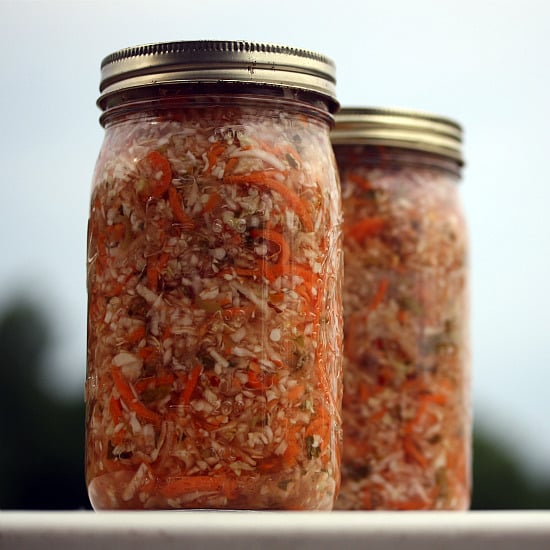
I enjoy “regular” sauerkraut well enough (I’ve blogged about making lacto-fermented sauerkraut), but was looking for something else to make with my homegrown cabbage in honor of the Preserve the Bounty Challenge going on over at Nourished Kitchen. I found a recipe for Cortido in the book Nourishing Traditions, then toyed with it a bunch to get what you see here.
This recipe is made using the lacto-fermentation method. Lacto-fermentation is how I make my pickles and lots of other health-enhancing goodies…it’s my favorite way to preserve vegetables. Lacto-fermented foods are live foods, which means they’re high in nutrients, as well as enzymes and natural probiotics. They also taste great.
Most lacto-fermented vegetable recipes do not contain vinegar. Instead they rely solely on salt and the natural acids created in the fermentation process for preservation. This recipe differs a bit because it uses both.
Please note that this is not a traditional curtido recipe. This is my own version, which uses fresh ginger, green apple, and kale. I know this isn’t how it’s made in El Salvador. Please also note that you really taste the vinegar in here; if you aren’t a fan of vinegar, you’ll want to use less of it, and add more water.
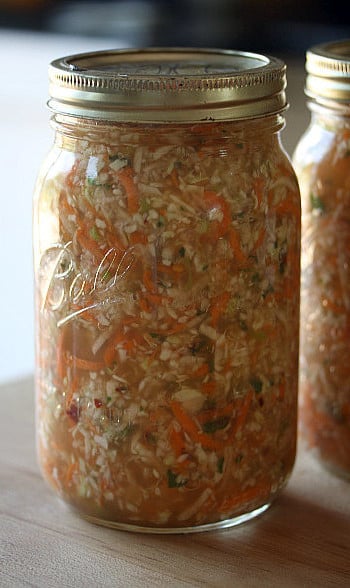
I shredded everything for this recipe in my food processor. I used the fine shredding disc, but you can use the thin shredding one, if you prefer. You could also shred everything by hand.
This curtido is really flavorful. I’ve been mixing it into salads and wraps, and it went great with a chorizo and potato dish I made recently, as well. One of these days, I’ll try my hand at pupusas, too.
Once the initial fermentation is over, you can store your curtido in the refrigerator, where it will keep for 1-2 months. I’m sure you’ll think of lots of ways to use it in that time frame.
Fermented Curtido (Salvadoran Cabbage Relish)
Ingredients
- 1 head cabbage small head with outer leaves removed and cored
- 3 Carrots large, scrubbed (and peeled if not organic)
- 1 onion peeled
- 1 thumb ginger fresh and peeled (use less if you aren't a ginger fan)
- 1 cup kale approximately 1-2 handfuls fresh kale leaves, tough stems removed
- 1 apple green, cored
- 2 tsp oregano dried (optional)
- 1/2 tsp red pepper flakes or more to taste
- 1 tbsp sea salt
- 1.5 cups apple cider vinegar use raw, "with the mother"
- 1.5 cups water plus more if necessary
Instructions
- Shred cabbage through apple in a food processor (or chop fine by hand). Transfer to a large bowl and mix with oregano and red pepper flakes.
- Spoon cabbage mixture into 2 quart-sized jars and press down with the back of a wooden spoon. Leave 1 inch of space between the top of the cabbage and the top of the jar.
- In a small bowl, mix the salt with the vinegar and water. Pour evenly over both jars of the cabbage, then add more water to both, if needed, so that the liquid is level with the cabbage.
- Cover jars tightly and leave at room temperature for 3 days. Store long-term in the refrigerator.
Nutrition
This recipe was originally published in August 2010.

